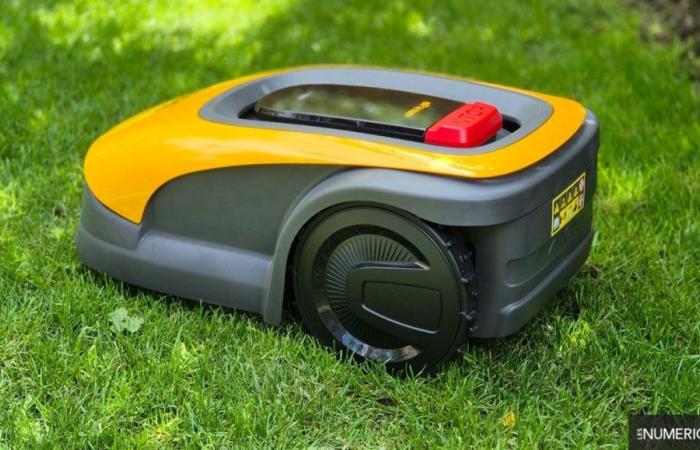Stiga is a renowned brand in the garden maintenance market, offering a wide range of lawnmowers, but also other tools such as hedge trimmers, blowers, chainsaws, scarifiers, etc.
Based on this expertise, it now offers autonomous robotic lawnmowers, capable of operating without cables or antennas. This is the A series, which is available in no fewer than nine models. In fact, the main difference lies in the recommended mowing area, ranging from 300 to 10,000 m².
Here we are testing the A 1500, recommended for an area of up to 1500 m². Like the rest of the range, this robot uses GPS technology to find its way and does not require the installation of cables or physical beacons in the garden. In addition, unlike most models on the market, it has 4G connectivity that is always available, without having to worry about the wifi network.
This robot lawnmower is offered at a price of €2,999, relatively high compared to the competition.
Equipment and installation
The Stiga A 1500 is particularly compact with dimensions of 545 x 405 x 245 mm and a weight of 16.9 kg. The manufacturing quality is generally good and its IPX5 certification ensures resistance to bad weather. It is therefore possible to rinse it frequently with a low-pressure water jet to clean it, without fear of damaging it. The robot’s shell is also removable, which simplifies repair and maintenance.
The design is quite modern, although a little too plastic. The colors are gray and matte on the sides, while the upper part is yellow, which gives it a racy aesthetic, but not very discreet in a garden. On the front, a hole seems to hide an obstacle sensor or a camera, when in reality it is the charging connectors.
Unfortunately, the Stiga A 1500 does not have advanced obstacle detection and therefore cannot anticipate them while mowing.
On the top, we find the classic red Stop button to interrupt mowing in an emergency, as well as a particularly disappointing control panel that seems to come straight from the 1990s. Unlike most competitors, there is no screen and you have to make do with a few colored LEDs to try to interpret the status of the robot.
The base itself is unoriginal and seems oversized compared to the size of the robot. An optional protective cover can be added against projections, but is not necessary on a daily basis.
The base also incorporates a reference station, which allows the robot to position itself reliably. In fact, like other robotic mowers, the Stiga A 1500 uses GPS-RTK technology to locate itself. However, it does not require the installation of a separate reference station, as this is integrated into the base.
This approach allows the robot to locate itself without requiring perimeter cables or the installation of beacons. In addition, since the reference station is integrated into the base, there is no need to install one separately, which reduces constraints.
Pairing is done via Bluetooth, as is the creation of mowing zones, prohibited areas and paths. This task is carried out by controlling the robot from the smartphone and moving it along the edges. The position of the Stiga A 1500 is displayed on a satellite map to better locate yourself. Unfortunately, this lacks precision, as evidenced by our map which showed the robot mower on the tarmac rather than in the garden.
It is then possible to automatically follow the path or add the points manually. The app also allows you to add obstacles or temporary prohibited areas, useful in summer to avoid an inflatable spa, for example. In total, the Stiga A 1500 can manage up to 10 separate zones, allowing you to precisely adjust the cutting strategy.
Following this step, the robot moves along the edges to confirm the route. This sometimes lacks precision, but fortunately it is possible to modify each point manually. However, this must be done point by point, particularly because the robot retraces the route after each modification. In the case of large areas, this step can quickly become very time-consuming, especially if the initial route is not very precise.
The cutting height adjustment is electronic, directly from the app, ranging from 20 to 60 mm. The same goes for the cutting direction, which can be adjusted for each area.
Ergonomics and use
The Stiga A 1500 is controlled via the Stiga Go application, which is quite intuitive and allows you to finely adjust many mowing parameters. Communication is via 4G without any additional subscription.
The robot can be programmed automatically or by creating a custom program. This can be defined for each area, as can the parameters and cutting height. It is possible to exclude certain areas, either permanently or temporarily, and to activate or not the mowing of the edges.
The control panel also allows you to start mowing, but the ergonomics are so unintuitive that it is better to use the application. You have to make do with two buttons and three LEDs to interact with the robot, which is not very obvious. In addition, the Stiga A 1500 is not secured by a PIN code. It uses a kind of key placed under the panel, easy for malicious people to remove.
Furthermore, the Stiga cloud is not compatible with voice assistants, so it is impossible to start mowing using a connected speaker, unlike most competing robot mowers.
During mowing, the Stiga A 1500 simply indicates the status on the app, but does not display the progress on the map. It is also particularly discreet and quiet, emitting only 57 dB. In fact, this noise level is not noticeable outdoors, because it mixes with the ambient noise.
The Stiga A 1500 features a 5000mAh ePower battery that allows it to mow up to 1500m² in two sessions in one day. This is designed for increased durability, retaining up to 80% of its capacity after around four years.
Mowing efficiency and quality
With such features and advanced customization options, the Stiga A 1500 seems like the perfect robotic lawnmower. However, things get tricky when it comes to mowing the lawn. During our tests, starting a manual cycle was far from immediate, sometimes requiring a wait of up to 45 minutes to pick up the satellites.
Indeed, GPS-RTK positioning technology requires reliable reception of enough satellites to position itself correctly. However, it is not acceptable to have to wait so long for the positioning to be established. However, Stiga offers to create a personalized mowing schedule based on the location of the satellites in order to optimize the signal. In practice, it would be advisable to be able to start mowing whenever you want and not according to external criteria.
The Stiga A 1500 uses a four-blade cutting deck with a width of 18 cm. This is sufficient for mowing large areas, but is smaller than what other robots offer, which can reach up to 22 cm.
During mowing, the robot mower leaves no traces in its path thanks to its lightweight design. This approach minimizes the impact on the lawn and thus avoids damaging it. On the other hand, unlike the Dreame A1, the robot does not leave parallel stripes on the lawn, which could have improved the aesthetic appearance of its work.
The grass is generally well cut, but there are occasional missed areas, particularly along edges and corners. We ran another robotic lawnmower using a different positioning technology just after the Stiga A 1500, and could hear it cutting grass in different places on the lawn, demonstrating that the A 1500 wasn’t following a tight enough and precise path.
However, it never got stuck or lost and managed to return to its base every cycle. It is also designed for difficult terrain, as it is capable of handling slopes of up to 25% or 24º.
As for obstacles, the Stiga A 1500 can only identify them when it touches them. It is therefore important to ensure that no objects have been left on the lawn, at the risk of them being mowed or damaged. This is particularly the case with pipes, which the robot may not detect. In the case of a larger obstacle, such as a piece of furniture, the robot will avoid it after hitting it, which is quite unreliable if you have children or pets.
Maintenance of the device is very simple, since you just need to rinse the robot and its station with a low-pressure water jet to remove the grass and soil that accumulates there.






